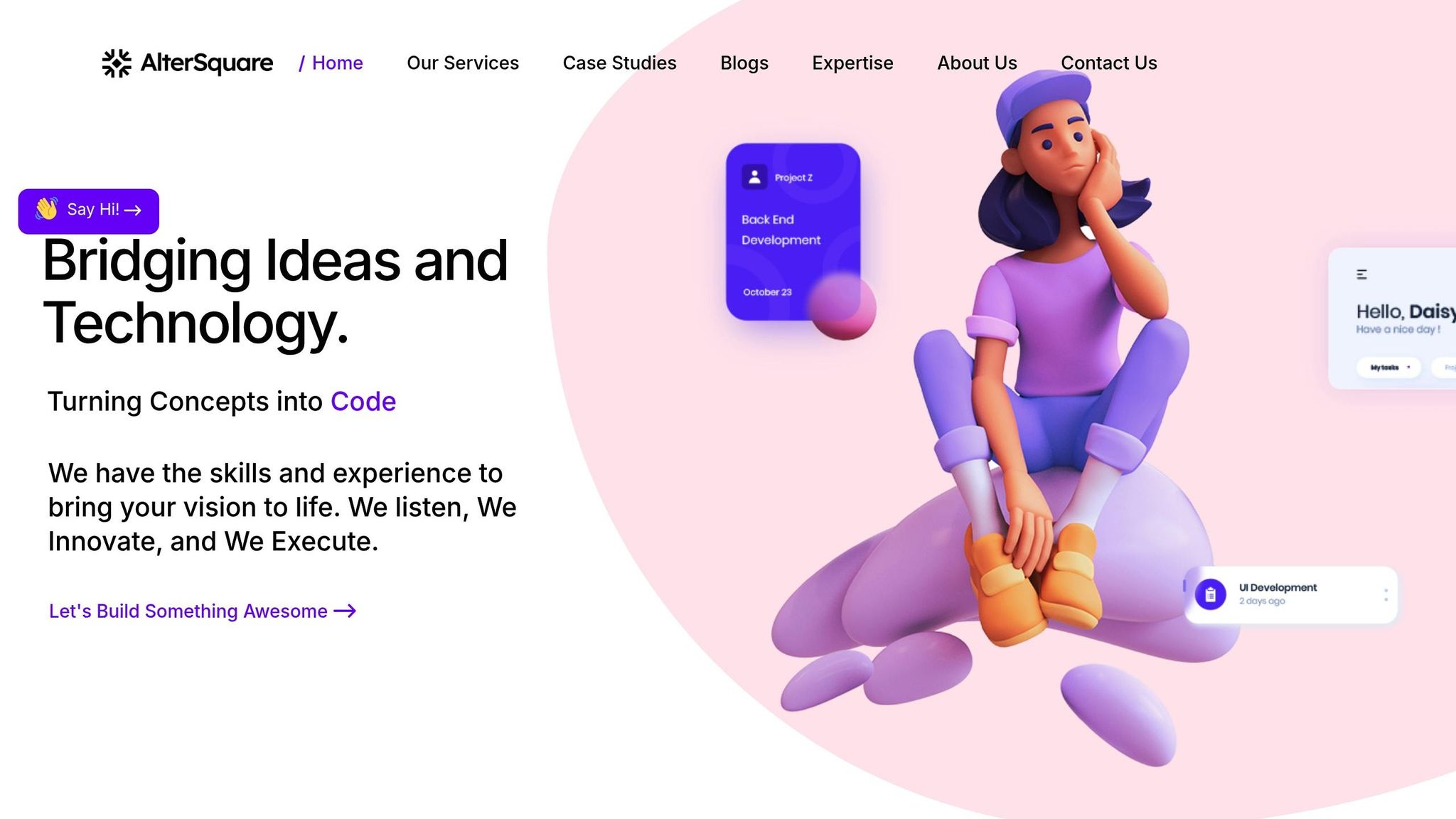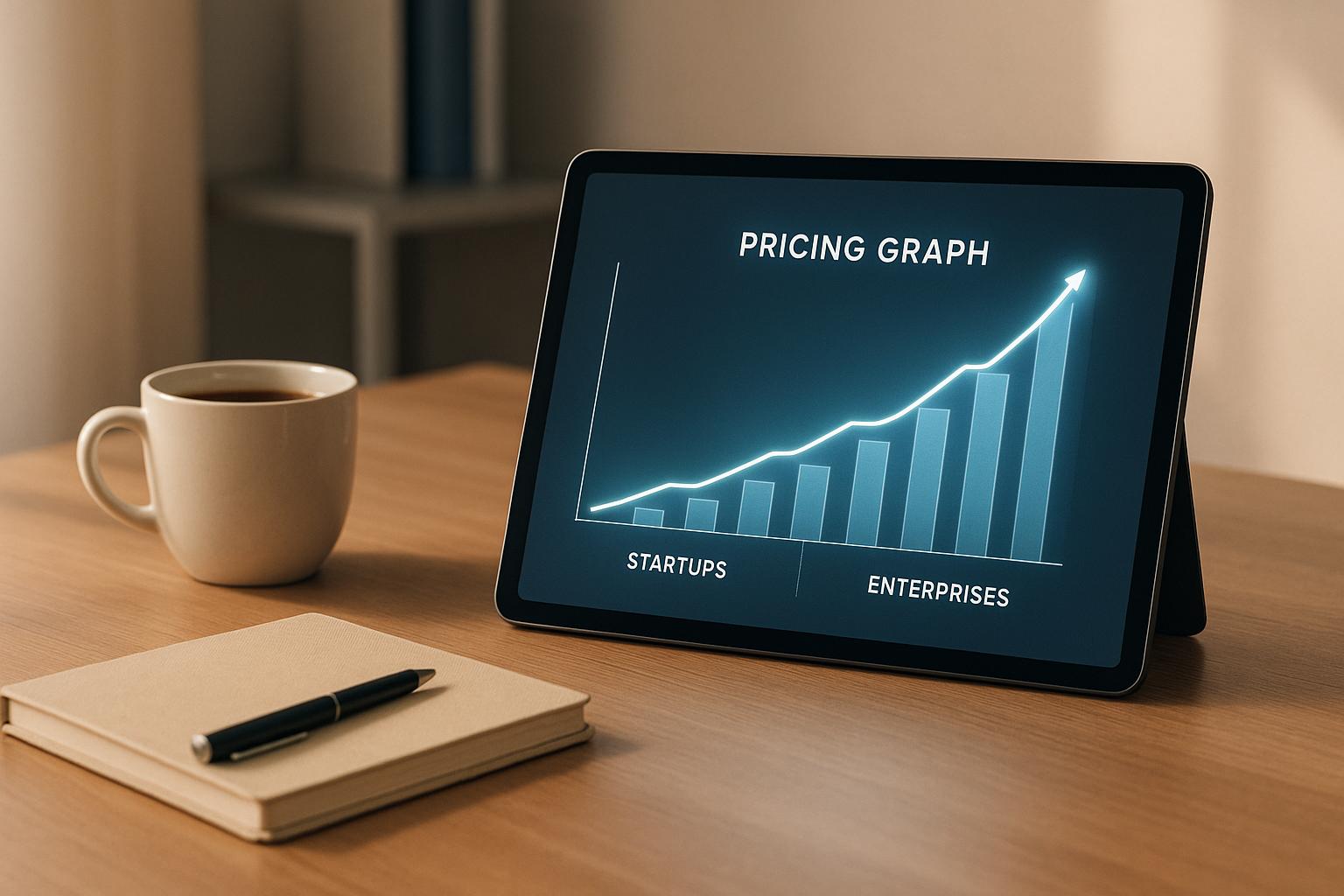Usage-based pricing (UBP) is reshaping how SaaS companies charge for their services. Instead of fixed fees, customers pay based on how much they use. While this model works well for startups and smaller businesses, it can create challenges for enterprises that prefer predictable costs. The key is balancing flexibility for smaller users with revenue stability for larger clients.
Here’s what matters most:
- Hybrid Pricing Models: Combine fixed fees with usage-based charges to meet diverse customer needs.
- Tiered Pricing: Offer Basic, Standard, and Premium tiers to cater to different customer segments.
- Custom Enterprise Agreements: Tailor contracts with volume discounts and minimum commitments for large clients.
- Transparent Tools: Provide usage dashboards, alerts, and clear invoices to build trust and reduce surprises.
Companies like Snowflake and New Relic have successfully shifted to UBP, achieving higher customer retention and revenue growth. By focusing on customer outcomes, refining pricing based on data, and offering flexibility within structured plans, businesses can grow without losing enterprise deals.
Usage-Based Pricing: The Next Evolution in Software Pricing
How to Structure Usage-Based Pricing Models
Designing a usage-based pricing model takes careful planning. The goal is to strike a balance: offering smaller customers an affordable way to get started while still delivering value to larger clients. Here’s how to build a pricing structure that works for both ends of the spectrum.
Creating Tiered Pricing Frameworks
A tiered pricing system based on usage and value is an effective way to meet diverse customer needs. By clearly defining tiers, businesses can appeal to startups looking for cost-effective solutions and enterprise clients who need advanced features and services.
A common approach is a three-tier framework: Basic, Standard, and Premium. Each tier serves a distinct audience:
- Basic: Designed for startups, this tier includes essential features at a low cost. It’s a great entry point for smaller customers with limited budgets.
- Standard: Ideal for growing businesses, this tier builds on the basics with added functionality to support scaling operations.
- Premium: Tailored for enterprise clients, it includes advanced features and high-touch services like priority support and custom onboarding.
Start by identifying your customer segments and the specific value metrics that resonate with each group. Regularly review and adjust your tiers based on customer feedback and market trends to ensure your pricing stays competitive and reflects the value you provide. Beyond tiered pricing, incorporating contracts can add stability to your revenue stream.
Setting Minimum Commitments and Contracts
Introducing minimum commitments can help stabilize revenue, especially with enterprise customers. Combining a fixed base fee with usage-based charges creates a predictable revenue floor while maintaining the flexibility that attracts a wide range of clients.
Volume discounts or lower per-unit rates for committed usage can motivate customers to meet minimum thresholds. At the same time, entry-level plans should remain accessible to smaller businesses. Providing tools like real-time usage tracking and automated alerts can prevent unexpected costs, giving customers greater confidence in managing their budgets.
Interestingly, not all large customers prefer discounts. Peter Goldmacher, New Relic’s VP of Investor Relations, observed:
"What we have been surprised to see is that some of our largest customers have said, ‘We really don’t want to commit to anything and are comfortable paying rack rate’" [1].
This highlights the importance of offering flexibility alongside structured plans.
Differentiating Features and Service Levels
A well-structured pricing model also depends on clearly segmented features and service levels. Enterprise plans typically include advanced options like enhanced security, compliance tools, detailed analytics, and robust integration capabilities. These features go far beyond the basics offered in lower tiers.
Service enhancements for enterprise clients might include dedicated account managers, faster response times, priority support, and tailored onboarding services. These added benefits not only justify higher pricing but also provide a clear incentive for customers to upgrade as their needs grow.
Custom integrations and white-labeling options can further elevate enterprise offerings, making them more appealing to larger organizations. By combining customer data analysis with market research, you can refine each tier to meet specific needs while keeping the overall structure simple and effective.
How to Protect Enterprise Deals
When it comes to enterprise customers, pricing strategies need to strike a balance: offering flexibility for smaller users while ensuring predictable revenue streams. Hybrid pricing models and custom agreements are two key approaches that can help achieve this balance.
Using Hybrid Pricing Models
Hybrid pricing is about blending the stability enterprises need with the adaptability smaller customers value. This approach combines a fixed base fee for essential services with a usage-based charge for variable consumption. A great example of this is Intercom’s 2024 rollout of their "Fin AI" chatbot. They kept seat-based subscriptions for human agents but introduced usage-based pricing for AI interactions [4].
"Hybrid pricing allows businesses to offer services or products that more closely align with customers’ perceived value… increasing customer satisfaction and attracting a broader customer base." – DigitalRoute [6]
Another example is Microsoft Azure‘s burstable reserve model. It uses CPU credits that accumulate during low usage and can be applied during high-demand periods, offering enterprises the flexibility they need [7]. The success of hybrid pricing lies in deciding which services should be tied to fixed fees and which usage metrics best reflect customer value.
Creating Custom Enterprise Agreements
For enterprise customers, pricing predictability often outweighs flexibility, making custom agreements a cornerstone of high-value deals. Although more than 60% of SaaS companies use pay-as-you-go pricing [7], enterprise clients often require tailored solutions that go beyond standard pricing tiers.
Custom agreements can include features like minimum usage thresholds to secure revenue, annual commitments for long-term stability, and volume discounts for high consumption. To design these agreements effectively, companies need to gather detailed data on customer use cases, user roles, industry requirements, and company size. This data helps create tailored pricing structures, credit pools, and overage calculations that meet specific needs. Using standardized contract templates with flexible clauses can simplify the process, and integrating CRM systems, billing platforms, and contract management software ensures smooth execution [8]. These agreements pave the way for effective account management and clear communication of value.
Managing Accounts and Communicating Value
Proactive account management and transparent communication are vital in usage-based pricing models. Offering tools like real-time usage tracking, automated alerts, and spending dashboards can help customers avoid unexpected bills. Clear, itemized invoices that separate subscription fees from usage charges further enhance transparency [5].
"Hybrid pricing enables stronger expansion revenue from existing customers. By incorporating a usage-based component, companies see a steady increase in spending from their user base without having to rely solely on new customer acquisition." – DeAdra Walker, Maxio [5]
Focusing on benefits rather than just features is equally important. Highlighting value-adds such as advanced security, compliance tools, dedicated support, and custom integrations can justify premium pricing. Regular business reviews that showcase ROI and identify opportunities for optimization strengthen enterprise relationships. Additionally, monitoring usage patterns allows businesses to proactively offer personalized support or strategic discounts, reducing churn and driving growth [3]. By combining automated tools with human interaction, companies can deliver the strategic guidance and relationship management that enterprise customers expect.
sbb-itb-51b9a02
Tools and Methods for Implementation
Shifting from traditional pricing to usage-based models demands thoughtful planning and the right tools. Interestingly, 67% of SaaS companies now use usage and consumption-based pricing, a jump from 52% in 2022, with some predicting 38% higher revenue growth compared to traditional pricing approaches [2][11].
Running Pilot Programs and Gradual Rollouts
Pilot programs are a smart way to test new pricing strategies without risking existing revenue. One effective method is cohort testing, where the new pricing model is applied only to new customers, leaving existing ones on their current plans. This approach allows you to run tests for 3–6 months while tracking metrics like conversion rates, revenue growth, and customer satisfaction. To refine your strategy, compare results with historical data and gather feedback through surveys and interviews [12].
Another option is inviting a diverse subset of customers to participate in structured pilot programs. Offer incentives like discounts or extra features, and clearly communicate the test’s purpose and timeline. Collect feedback through regular check-ins and usage reviews, allowing you to compare predicted versus actual usage and revenue patterns [12].
"The right value metric grows with the customer’s perceived value of your product." – Patrick Campbell, Pricing Expert [12]
A shadow billing approach can also provide valuable insights. Here, customers are billed under their current plan but shown what they would pay under the new model. Including this "for information only" section on invoices helps you gather data and understand customer reactions without impacting current revenue [12].
For a gradual rollout, take a phased approach: start with new customers, then expand to specific groups of existing customers, and finally roll it out across your entire customer base. Offering hybrid models – like combining subscription fees with usage-based charges or tiered plans – can also ease the transition [12].
These methods set the stage for leveraging advanced billing tools, which are essential for scaling.
Using Tools for Usage Tracking and Billing
Effective usage tracking and billing platforms are crucial. They should offer real-time data capture, support for flexible pricing models, automated invoicing, and detailed reporting [11]. When selecting a platform, prioritize scalability, integration options, customization capabilities, and security.
Several tools stand out in this space:
- Orb: Tailored for complex B2B SaaS billing, with pricing based on need and event volume [9].
- Stripe Billing: Offers pay-as-you-go pricing at 0.7% of billing volume or monthly plans starting at $620 for up to $100,000 in billing volume [10].
- Maxio: Focuses on B2B SaaS companies, with a Grow plan at $599/month for up to $100,000 in monthly billings [10].
- Chargebee: Includes a free starter plan until billing exceeds $250,000 annually [9].
To implement these tools effectively, start by defining your usage metrics and selecting the appropriate meter types, such as Counter, Gauge, or Delta, depending on the level of detail you need. Decide between tiered or volume-based pricing and set clear rates and thresholds. Use APIs or database integrations to establish data pipelines and configure billing rules based on real-time usage data [13].
For example, 100ms, a video infrastructure startup, streamlined its billing by automating with Zenskar. This eliminated invoicing errors, increased revenue by 4%, and provided real-time usage reports and customer-facing dashboards, improving customer retention [13].
Providing customers with real-time dashboards to track their usage and automating invoicing processes can reduce errors and enhance efficiency [11].
AlterSquare‘s Expertise in Scalable Pricing Models

Transitioning to usage-based pricing requires a robust technical foundation capable of handling complex pricing structures. AlterSquare specializes in building scalable systems that address these challenges through a 90-day MVP development cycle, helping startups lay the groundwork for flexible pricing models from the start.
Our Product Engineering services focus on developing systems that grow alongside your pricing strategy. We design architectures that enable real-time usage tracking, automated billing, and seamless integration with third-party billing platforms, reducing the need for costly system overhauls.
For startups looking to scale, our Application Modernization services revamp existing product architectures to ensure they can handle advanced pricing tiers, usage tracking, and enterprise-level billing needs – all while maintaining performance and continuity.
We also offer AI-Driven Solutions to enhance pricing strategies. These include tools for analyzing usage patterns, forecasting billing trends, and automating customer segmentation. This allows businesses to fine-tune their pricing models and uncover new revenue opportunities without disrupting relationships with key customers.
Through Software Consulting, we provide strategic guidance to help founders navigate the technical and business challenges of adopting usage-based pricing. Our expertise in pilot programs and billing tool integration ensures that pricing systems are scalable, protect revenue, and cater to the needs of diverse customer segments.
Case Studies and Examples
Building on earlier strategies, these real-world examples highlight how companies navigate the delicate balance between offering flexibility and safeguarding revenue. These examples uncover both the opportunities and challenges of making usage-based pricing (UBP) work across different customer types.
Case Study: Moving to UBP Without Losing Enterprise Revenue
The story of New Relic’s 2020 pricing transformation is a powerful example of shifting to UBP while preserving enterprise revenue. The company moved from host-based pricing to a model focused on data ingestion. CEO Lew Cirne called this transition "the most important moment in New Relic’s 13-year history" [14].
Their success came from aligning the entire organization around this new approach. They chose a customer-centric value metric, revamped sales incentives to reward usage growth instead of traditional renewals, and held product teams accountable for driving revenue [14].
Another standout example is Snowflake, which charges customers based on compute and storage usage rather than fixed fees. This approach fueled their growth from $96.7 million in revenue in 2019 to over $2 billion in 2023. Snowflake also boasts a net revenue retention rate consistently above 170%, showing that enterprise customers tend to increase their spending significantly over time [15].
Autodesk took a more gradual approach, rolling out its Flex model alongside traditional subscriptions. This phased strategy allowed them to experiment with UBP while maintaining strong enterprise relationships. They also introduced self-serve tools to help customers estimate token usage, which increased adoption and reduced churn among key accounts [14].
These examples show that gradual rollouts, hybrid models, and clear communication are crucial for successfully implementing UBP. They also provide a foundation for comparing how UBP impacts different customer groups.
Comparing UBP Across Customer Segments
Usage-based pricing affects customer segments differently, which calls for tailored strategies to maximize its benefits and minimize risks.
| Customer Segment | UBP Advantages | UBP Challenges | Recommended Approach |
|---|---|---|---|
| Startups | Lower entry costs; scales with growth | Unpredictable expenses; hard to forecast | Offer free tiers, usage caps, and real-time cost dashboards |
| SMBs | Value-based payments; seasonal flexibility | Need for cost predictability; limited budgets | Use hybrid models with base fees and usage add-ons |
| Enterprises | Aligns with business outcomes; potential for upselling | Complex budget approvals; preference for fixed costs | Offer custom contracts with volume discounts and committed usage terms |
Data backs this segmented approach. For example, customers in UBP models tend to increase their spending by 25% more annually compared to those in subscription-based models [15].
Twilio is a great example of a single UBP structure working across diverse segments. By charging only for messages sent, calls made, or verifications completed, Twilio keeps its pricing simple yet effective. Their net dollar expansion rate has stayed above 130% for years, proving that well-thought-out usage metrics can drive growth across all customer types [15].
These segmented insights are further supported by lessons from industry leaders.
Lessons from Industry Leaders
Top companies that have embraced usage-based pricing show that aligning pricing with customer value is the cornerstone of long-term growth.
Amazon Web Services (AWS) is a prime example, using its pay-as-you-go model to achieve an $80 billion annual revenue run rate in 2023 [15]. AWS’s success emphasizes the scalability of UBP when paired with transparent pricing and effective customer education.
Cypress, a more recent adopter, launched its UBP model in 2021. They prioritized customer feedback throughout the process, ensuring the pricing structure met user needs. By making this shift an organizational focus and encouraging open discussions on implementation, Cypress successfully aligned its pricing strategy with customer expectations.
Todd Gardner, CEO of SaaS Capital, sums it up well: "usage-based pricing creates a direct link between the value a customer receives and what they pay" [15]. This approach fosters sustainable growth, benefiting both startups exploring product-market fit and enterprises scaling operations.
Across these examples, one thing is clear: adopting UBP requires more than just a pricing tweak. Companies that invest in customer research, phased rollouts, and cross-departmental collaboration are better equipped to protect and grow enterprise relationships while meeting the needs of smaller customers.
Best Practices for Long-Term Growth
Achieving sustainable growth requires a pricing strategy that bridges the gap between startup accessibility and enterprise value. Usage-based pricing (UBP) offers a powerful way to strike this balance, and companies excelling with this approach follow specific principles to secure revenue while expanding their market presence.
Key Takeaways for Founders
Tie pricing to customer outcomes. Pricing should reflect the value customers gain from your product. Todd Gardner from SaaSonomics highlights the importance of focusing on high-growth customers:
"As this model shows, the growth of the business is much more sensitive to modest changes in the High Growth segment than any other segment. If the business increased its pool of high growth customers from 5% to 6%, its ten-year growth rate would improve 1.5 percentage points to 15.1%. Conversely, were it to improve its churn from 10% to 9%, growth would only improve .2 percentage points. This is the asymmetric nature of growth customers vs. churned customers, and UBP is an amplifier on the much more powerful growth side" [18].
Adopt hybrid pricing models. Combining predictable base fees with variable usage charges offers the best of both worlds. Research by OpenView reveals that 61% of SaaS companies now use hybrid pricing models [18]. This approach drives revenue growth, with two-thirds of existing customers increasing their spend [18].
Be transparent to build trust. Clear communication about pricing changes helps reduce churn and strengthens customer relationships. Tailor your messaging for different audiences – highlighting the benefits for both new and existing customers.
Empower customers with real-time usage tools. Usage dashboards and spending alerts can help customers monitor their costs. Features like threshold notifications and spending caps ensure customers avoid surprises and optimize their usage.
Regularly refine pricing based on feedback and data. Pricing isn’t a one-and-done task. As Zuora points out: "Pricing is not a project, it’s a process" [19]. Adjust your strategy as customer needs and market conditions evolve.
These practices lay the groundwork for aligning pricing with your broader growth objectives.
Aligning Pricing with Growth Goals
To ensure long-term success, focus on strategies and metrics that support sustainable growth.
Prioritize key growth metrics. Companies using UBP achieve 17% annual revenue growth compared to the industry average of 13% [17]. Keep a close eye on customer acquisition cost (CAC), customer lifetime value (CLTV), net revenue retention, and usage trends to maintain momentum.
Prepare for scalability and adaptability. Your pricing model should evolve with your customer base and market shifts. Many early-stage startups are embracing this mindset, with 64% of Forbes’ Next Billion-Dollar Startups using UBP models [16].
Balance stability with flexibility. For enterprise customers, ensure predictable costs while allowing room for scalable usage. Offer features like volume discounts, committed usage terms, and hybrid contracts that meet enterprise needs while supporting growth.
Customize strategies for different customer segments. Tailor your approach to address the unique needs of startups, SMBs, and enterprises:
- Startups benefit from free tiers and clear usage caps.
- SMBs value seasonal flexibility paired with predictable base costs.
- Enterprises often require custom contracts with volume discounts.
The most successful companies treat UBP as more than just a pricing tweak – it’s a holistic business strategy. They focus on educating customers, maintaining transparency, and fine-tuning their models based on real-world usage and feedback. By doing so, they create a foundation for sustainable, long-term growth.
FAQs
How can SaaS companies design usage-based pricing that avoids unexpected costs for enterprise clients?
To help enterprise clients avoid surprise expenses, SaaS companies can adopt pricing strategies that emphasize clarity and control. One popular option is tiered usage pricing, where customers are billed based on predefined usage levels. This setup makes it easier for businesses to anticipate their costs.
Another approach is introducing usage caps, which set limits on how much a client can use within a billing period. This not only prevents unexpected overage charges but also creates opportunities for clients to upgrade if they require additional capacity. On top of that, providing real-time usage tracking and alerts ensures clients stay informed about their consumption, giving them the chance to adjust before hitting any limits.
By blending these strategies, SaaS providers can deliver the flexibility of usage-based pricing while ensuring enterprise clients have the transparency and predictability they need.
What are the advantages of using hybrid pricing models when transitioning to usage-based pricing?
Hybrid pricing models strike a balance by blending the adaptability of usage-based pricing with the consistent revenue of traditional subscriptions. This combination helps businesses appeal to a broader audience, ranging from small startups to large enterprises, while still ensuring steady income.
With a hybrid approach, companies can more effectively segment their customers and offer solutions tailored to different needs. It also makes it easier for smaller clients to get started, while preserving the appeal of high-value deals for larger organizations – giving businesses an edge in a competitive market.
What are the best ways to test and roll out usage-based pricing without disrupting existing customer relationships?
To roll out a usage-based pricing model smoothly, it’s crucial to take a gradual approach. Start by grandfathering your current customers into their existing pricing plans. This ensures they aren’t immediately impacted, which helps preserve their trust. Next, consider running A/B tests with smaller groups of customers to see how the new pricing compares to the old one in terms of performance and reception. Throughout this process, make it a priority to gather customer feedback. Their input can help you fine-tune the model and address any concerns that arise. By following these steps, you can adjust your pricing structure in a way that meets customer needs without disrupting existing relationships.









Leave a Reply